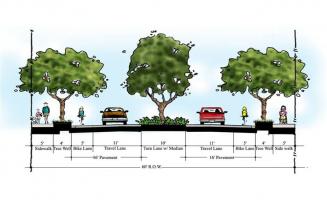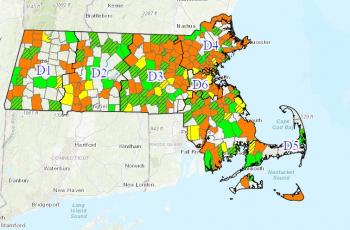Complete Streets
Fairhaven Complete Streets - The purpose of the Complete Streets program is to improve connectivity and mobility for all users and ages. This includes both design and infrastructure projects that will create an integrated transportation network that provides better accommodations and options for all transportation modes, users and ages and encourages healthy transportation alternatives. Let us hear from you - email planner@fairhaven-ma.gov
Fairhaven Complete Streets Policy (Tier 1) - Approved by BoS and MassDOT February 2021
Fairhaven Complete Streets Priortization Plan 2021 - Approved by MassDOT
Complete Streets 2021 (Tier 3) - $332,636 Approved for 4 Projects on Prioritization Plan (to be implemented in 2022)
- Alden Road bike lanes from Howland Street to Whaler's Way (#1)
- Crosswalks, ADA Ramps, & flashing beacons at FHA/Osfod Terrace adn Fairhaven Village on Main plus bus shelter at FHV.
- Flashing Speed Signs on Sconticut Neck Road near Manahttan Avenue.
- Crosswalks and flashing beacons at Orchard Street and SNR.
Shared Streets 2021 - $183,689 approved for 2 projects on the Prioritization Plan approved by the Shared Streets Program
- Main Street & Phoenix Rail Trail RFB, wheelchair ramps and crosswalk;
- Alden Road intersections with Glenhaven and Howland & nearby RFB, wheelchair ramps and crosswalk.
What are Complete Streets? - "Complete Streets are streets for everyone." SmartGrowthAmerica.org
 A Complete Street describes a public right of way that provides safe and accessible options for people of all ages, abilities, and modes of travel. A network of Complete Streets expands travel choices by making it easy for people to cross the road, walk to school, bicycle to work, or hop on and off buses and trains. Complete Streets are designed with all users in mind, and they make non-motorized transportation more convenient, attractive, and safer.
A Complete Street describes a public right of way that provides safe and accessible options for people of all ages, abilities, and modes of travel. A network of Complete Streets expands travel choices by making it easy for people to cross the road, walk to school, bicycle to work, or hop on and off buses and trains. Complete Streets are designed with all users in mind, and they make non-motorized transportation more convenient, attractive, and safer.
What does a Complete Street look like?
Complete Streets are context sensitive. They have no fixed design because each right of way is different in place and purpose. A Complete Street in an urban area will look very different from a Complete Street in a rural area. What matters is that the elements of each street reflect the needs of the people who use it, regardless of age, ability, or mode of travel.
Complete Streets elements can be realized on a large sale (e.g., intersection improvements) or can be more narrowly focused (e.g., adding a single bicycle lane or crosswalk). The MassDOT Highway Division identifies the following as examples of Complete Streets infrastructure or project types:
• ADA/AAB-accessible curb ramps • Audible pedestrian signals • Bicycle parking facilities • Bus pull-out areas • Curb extensions • Designated bicycle lanes • Detectable warning surfaces • High-visibility crosswalks • Intersection signalization • Medians and pedestrian crossing islands • Pedestrian hybrid beacons • Radar feedback ("Your Speed") signage | • Road diets • Roundabouts • Signal prioritization • Shared lanes and shared-use paths • Street lighting • Street trees and furniture • Traffic calming measures • Transit-only lanes • Transit shelters • Sidewalks • Speed tables and raised crosswalks • Wayfinding signage |
For more information, please visit www.masscompletestreets.com , https://nacto.org/, and https://smartgrowthamerica.org/
Why Complete Streets?
Complete Streets help create livable communities for various types of users, including children, people with disabilities, and older adults. Complete Streets improve equity, safety, choice and public health, while reducing transportation costs and improving connectivity.
Complete Streets in Massachusetts
 In 2006, the Massachusetts Highway Department, which was succeeded by MassDOT, became one of the first transportation agencies in the country to realize the need to consider all users when building and renovating streets, parks, sidewalks, and parking lots statewide. At that time, MassDOT developed its Project Development & Design Guide.
In 2006, the Massachusetts Highway Department, which was succeeded by MassDOT, became one of the first transportation agencies in the country to realize the need to consider all users when building and renovating streets, parks, sidewalks, and parking lots statewide. At that time, MassDOT developed its Project Development & Design Guide.
With the Governor’s Transportation Policy Directive of 2014 and legislation, the MA Department of Public Health and MassDOT together established a funding program to encourage municipalities to routinely include Complete Streets design elements and infrastructure on locally-funded roads. This program consists of three tiers: Tier 1 - Establish a Complete Streets Policy; Tier 2 – Create a Complete Streets Prioritization Plan; Tier 3 – obtain funding for implementation of the improvements noted in the Tier 2 plan.
Since its launch in February 2016, 249 municipalities have registered to the program and 225 Complete Street Policies have been approved by MassDOT. Since the initiation of the program, funds have been used to construct improvements ranging from new sidewalks and crosswalk rehabilitation to bus stop improvement and installation of bicycle and shared lane markings.

